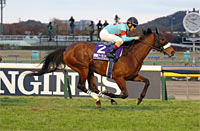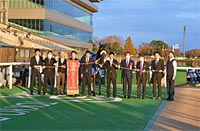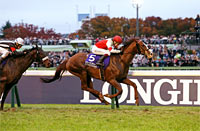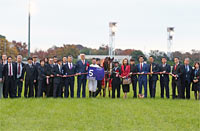Japan Cup (G1) - Data Analysis
Top contest over distance of 2,400m brings together stellar performers across generations
The Japan Cup has delivered a large number of memorable contests in recent years, with Triple Crown winners Gentildonna and Orfevre contesting the Top 2 in a thrilling spectacle in 2012, Kitasan Black triumphing with a formidable performance in 2016, and Almond Eye achieving a remarkable record-breaking victory in 2018. Let’s now identify some trends in this race based on results over the last 10 years.
Previous success in JRA G1 race is essential
The Japan Cup attracts top Japanese and overseas runners. Of the 30 Top 3 finishers over the last 10 years, 23 had experience of winning a JRA G1 race. This group also achieved an excellent Top 3 ratio of 37.1%. When making our predictions, we should first focus our attention on runners with experience of winning a JRA G1 race. [Table 1]
[Table 1] Performance by experience of winning JRA G1 race (last 10 years)
| Win experience |
Performance
[1st-2nd-3rd-4th or lower] |
Win ratio |
Top 2 ratio |
Top 3 ratio |
| Yes |
9-6-8-39 |
14.5% |
24.2% |
37.1% |
| No |
1-4-2-98 |
1.0% |
4.8% |
6.7% |
Incidentally, JRA runners without experience of winning a JRA G1 race achieved performance of [1-4-2-61] (Top 3 ratio of 10.3%), and the seven runners in this group that finished in the Top 3 had experience of finishing 0.2s or less behind the winner in a JRA G1 race. JRA runners without such experience did not make it into the Top 3, which suggests strong performance in JRA G1 races is essential to do well in this race. [Table 2]
[Table 2] Among JRA runners without experience of winning JRA G1 race, performance by lowest time difference with winner in JRA G1 race (last 10 years)
| Lowest time difference |
Performance
[1st-2nd-3rd-4th or lower] |
Win ratio |
Top 2 ratio |
Top 3 ratio |
| 0.2s or less |
1-4-2-25 |
3.1% |
15.6% |
21.9% |
0.3s or more, or
no such race entered |
0-0-0-36 |
0% |
0% |
0% |
Focus on horses aged 5 or below
Looking at performances by runners over the last 10 years in terms of age, we find that 28 of the 30 Top 3 finishers were aged 5 or below. The 24 6-year-olds produced zero Top 3 finishers, and the highest finishes for 7-year-olds were third place for Jaguar Mail and Tosen Jordan in 2011 and 2013, respectively. These two runners had experience of winning a JRA G1 race, but horses aged 6 and above with experience of winning a JRA G1 race only achieved performance of [0-0-2-13] (Top 3 ratio of 13.3%), reflecting lackluster success ratios. [Table 3]
[Table 3] Performance by age (10 years)
| Age |
Performance
[1st-2nd-3rd-4th or lower] |
Win ratio |
Top 2 ratio |
Top 3 ratio |
| 3 |
3-3-1-19 |
11.5% |
23.1% |
26.9% |
| 4 |
4-3-3-42 |
7.7% |
13.5% |
19.2% |
| 5 |
3-4-4-36 |
6.4% |
14.9% |
23.4% |
| 6 |
0-0-0-24 |
0% |
0% |
0% |
| 7 |
0-0-2-9 |
0% |
0% |
18.2% |
| 8 |
0-0-0-7 |
0% |
0% |
0% |
Watch runners that have contested JRA G1 or G2 race in previous race
Looking at performances by runners over the last 10 years in terms of the previous race, we observe that all 30 Top 3 finishers had either contested a JRA G1 or G2 race or the Prix de l’Arc de Triomphe in their previous race. Runners coming from the Tenno Sho (Autumn) made up over half of the Top 3 finishers. The few runners that had contested the Shuka Sho or the Kikuka Sho (Japanese St. Leger) in their previous race also delivered notable performance. Among runners that had contested a G2 race in their previous race, those coming from the Kyoto Daishoten produced two winners. Conversely, runners coming from the Copa Republica Argentina performed poorly, producing only one third-place finisher. [Table 4]
[Table 4] Performance by previous race (last 10 years)
| Previous race |
Performance
[1st-2nd-3rd-4th or lower] |
Win ratio |
Top 2 ratio |
Top 3 ratio |
| Tenno Sho (Autumn) (G1) |
5-4-8-40 |
8.8% |
15.8% |
29.8% |
| Shuka Sho (G1) |
2-1-0-2 |
40.0% |
60.0% |
60.0% |
| Kikuka Sho (G1) |
1-0-0-4 |
20.0% |
20.0% |
20.0% |
| Queen Elizabeth II Cup (G1) |
0-1-0-2 |
0% |
33.3% |
33.3% |
| Kyoto Daishoten (G2) |
2-1-0-14 |
11.8% |
17.6% |
17.6% |
| Kobe Shimbun Hai (G2) |
0-1-0-1 |
0% |
50.0% |
50.0% |
| Copa Republica Argentina (G2) |
0-0-1-17 |
0% |
0% |
5.6% |
| Prix de l’Arc de Triomphe (G1) |
0-2-1-7 |
0% |
20.0% |
30.0% |
| Race other than the above |
0-0-0-50 |
0% |
0% |
0% |
Also watch finish in previous race
Looking at performances by runners over the last 10 years in terms of finish in the previous race, we note that runners that had won their previous race delivered the highest number of Top 3 finishers (10 in total). In particular, runners that had won a JRA graded race in their previous race achieved performance of [3-3-4-7] (Win ratio of 17.6%, Top 2 ratio of 35.3%, and Top 3 ratio of 58.8%), boasting excellent success ratios. [Table 5]
[Table 5] Performance by finish in previous race (last 10 years)
| Finish in previous race |
Performance
[1st-2nd-3rd-4th or lower] |
Win ratio |
Top 2 ratio |
Top 3 ratio |
| 1st |
3-3-4-24 |
8.8% |
17.6% |
29.4% |
| 2nd |
2-2-0-27 |
6.5% |
12.9% |
12.9% |
| 3rd |
1-1-1-7 |
10.0% |
20.0% |
30.0% |
| 4th |
2-1-0-16 |
10.5% |
15.8% |
15.8% |
| 5th |
0-1-1-11 |
0% |
7.7% |
15.4% |
| 6th-9th |
2-1-2-27 |
6.3% |
9.4% |
15.6% |
| 10th or lower |
0-1-2-25 |
0% |
3.6% |
10.7% |
In addition, eight runners that had been beaten to 6th or lower in their previous race also finished in the Top 3. We should therefore consider the possibility of rebound performances by runners that have suffered a major defeat in their previous race. However, the same eight runners had all contested either the Tenno Sho (Autumn) or the Prix de l’Arc de Triomphe in their previous race. This suggests we should discount runners that were beaten to 6th or lower last time out in a race other than the aforementioned ones. [Table 6]
[Table 6] Among runners that had finished 6th or lower in previous race, performance by previous race (last 10 years)
| Previous race |
Performance
[1st-2nd-3rd-4th or lower] |
Win ratio |
Top 2 ratio |
Top 3 ratio |
| Tenno Sho (Autumn) |
2-1-3-24 |
6.7% |
10.0% |
20.0% |
| Prix de l'Arc de Triomphe |
0-1-1-2 |
0% |
25.0% |
50.0% |
| Race other than the above |
0-0-0-26 |
0% |
0% |
0% |
Seek out the winner!
Performance in 2,400m+ turf races offers clues
Nine of the 10 recent winners (excluding Shonan Pandora in 2015) had experience of winning a JRA graded turf race over a distance of 2,400m+ and had a Top 3 ratio of 75.0% or higher in such races, which are reassuring statistics. When predicting the race winner, performance in a previous JRA graded turf race over a distance of 2,400m+ may also be a factor worth considering. [Table 7]
[Table 7] Winners’ performance and Top 3 ratio in JRA graded turf race over distance of 2,400m+ (last 10 years)
| Year |
Winner |
Performance
[1st-2nd-3rd-4th or lower] |
Top 3 ratio |
| 2010 |
Rose Kingdom |
1-2-0-0 |
100% |
| 2011 |
Buena Vista |
1-3-0-0 |
100% |
| 2012 |
Gentildonna |
1-0-0-0 |
100% |
| 2013 |
Gentildonna |
2-0-0-0 |
100% |
| 2014 |
Epiphaneia |
2-1-0-0 |
100% |
| 2015 |
Shonan Pandora |
- |
- |
| 2016 |
Kitasan Black |
3-0-1-1 |
80.0% |
| 2017 |
Cheval Grand |
2-3-3-1 |
88.9% |
| 2018 |
Almond Eye |
1-0-0-0 |
100% |
| 2019 |
Suave Richard |
1-1-1-1 |
75.0% |
(Maya Takanami)
|




















